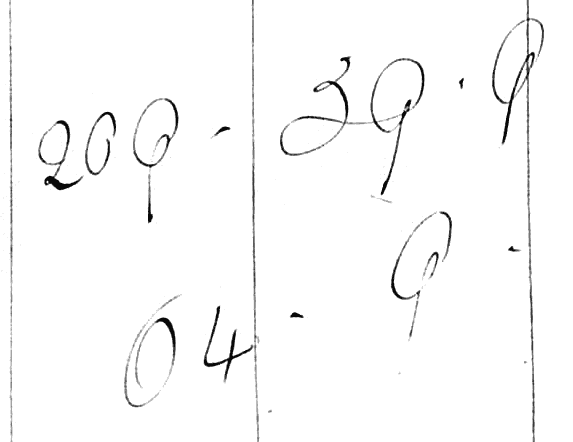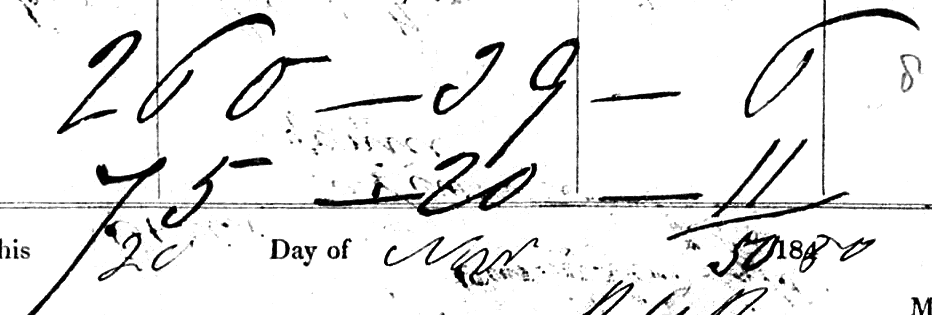Reading the writing
Examples of writing from Victorian documents
Victorian handwriting was sometimes good and sometimes awful. Some letters were written differently from the way they are written now. It's amazing how much clearer writing is when you've got your eye in, or someone tells you what it is!
Be methodical in reading a word. Go through letter by letter and identify which letters have ascending strokes (b,d,t etc) and which go below the line (g,y,p etc). Try to spot which are open letters (o,a etc) and which are likely to be closed (i,r etc).
As you identify letters, compare them with other words on the page which are written in the same hand. This will also alert you to quirks in the writer's hand, for example if they always write a letter W in a particular way.
This page shows examples of writing taken from Victorian documents and describes one or two pitfalls.
Upper case letters
Watch out for:
- Letters I and J are the real problem. They're often identical - look at Ida and Jane, and Isabella and James. They can also look like S - look at Susan in Lovely Susan. Some letter Js go below the line - look at Jim - but many don't. In people's names, capital J is more likely than capital I.
- Letters F and T, where the F should be crossed - look at Fame and Trial.
- Letter H can look like 'St' and vice versa - look at Hope and Stella Maris.
- Letter K can look like R and vice versa - look at Kingfisher and Recruit.
- Letters L and S can look similar - look at Lovely Susan.
- 'Ex' can look like G - look at Experiment and Grace Darling.
Lower case letters
Watch out for:
- Letters n, u and m are the major problem - look at Neptune, Rising Sun, Unity, Barbara Innes, Primrose and Stromness.
- Letters r and v - look at Livonia and Stella Maris.
- Uncrossed letter t - look at Catherine and Alice Abbott.
- Use of 'fs' for 'double s' - look at Messenger, Orissa and Stromness.
- Diphthongs like oe - look at Phoenix.
- An open letter p can look like 'fr' - look at Experiment, Napoleon and Spray.
- Many different ways of writing e - look at Henry Reed, for two ways in two words.
- Flourishes, up or down at the end of a word, or coming from a line above or below, can cause confusion
- Abbreviations like L'pl and H'pl (Liverpool and Hartlepool) need care. Look out for NB (ports in New Brunswick), NS (Nova Scotia) and Nfndlnd (Newfoundland) added to the name of a port.
- In the 'previous vessel' column of a crew list, knowing the ship's port is important. The port was often written either above or below the ship's name and it's sometimes not easy to tell which ship is being referred to.
Numbers
Watch out for:
- Numbers 1 and 7. 7 often has a long descender
- 8 was often written with a hook over, which can look like 6 or 5
- 0, 6 and 9 can be hard to pick apart.
- 4 can look like 11 and vice-versa.
Examples

Alert

Alfred the Great

Alice Abbott

Bloomer

British Queen

Barbara Innes

Catherine

Clarence

Cruizer

Danzig

David

Don Quixote

Effort

Envoy

Experiment

Fame

Friends

Fire Fly

Grace Darling

Grantham

Garibaldi

Henry Reed

Hope

Hortensia

Ida

Isabella

Iskander Shah

James

Jane

Jim

Kate

Kingfisher

Koh i nor

Lady Kate

Livonia

Lovely Susan

Majestic

Messenger

Myrtle

Naomi

Napoleon

Neptune

Only Son

Orissa

Osprey

Phoenix

Primrose

Port Glasgow

Quail

Queen of the Dart

Quorn

Rising Sun

Robert Bright

Recruit

Spray

Stella Maris

Stromness

Thomas & Ann

Three Brothers

Trial

Unity

Utopia

Useful

Venus

Victoria

Useful

Wolfe

Wye

Woodpecker

Xanthus

X L

Xerxes

Yare

York

Yarmouth

Zephyr

Zulu

Zurich

108-39-2

209-39-9,64-9

260-39-6,75-20-1
